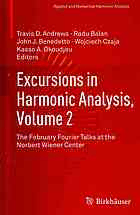
Excursions in harmonic analysis. : Volume 2 the February Fourier Talks at the Norbert Wiener Center PDF
Preview Excursions in harmonic analysis. : Volume 2 the February Fourier Talks at the Norbert Wiener Center
Applied and Numerical Harmonic Analysis SeriesEditor JohnJ.Benedetto UniversityofMaryland CollegePark,MD,USA EditorialAdvisoryBoard AkramAldroubi JelenaKovacˇevic´ VanderbiltUniversity CarnegieMellonUniversity Nashville,TN,USA Pittsburgh,PA,USA AndreaBertozzi GittaKutyniok UniversityofCalifornia TechnischeUniversita¨tBerlin LosAngeles,CA,USA Berlin,Germany DouglasCochran MauroMaggioni ArizonaStateUniversity DukeUniversity Phoenix,AZ,USA Durham,NC,USA HansG.Feichtinger ZuoweiShen UniversityofVienna NationalUniversityofSingapore Vienna,Austria Singapore,Singapore ChristopherHeil ThomasStrohmer GeorgiaInstituteofTechnology UniversityofCalifornia Atlanta,GA,USA Davis,CA,USA Ste´phaneJaffard YangWang UniversityofParisXII MichiganStateUniversity Paris,France EastLansing,MI,USA Forfurthervolumes: http://www.springer.com/series/4968 Travis D. Andrews (cid:129) Radu Balan John J. Benedetto (cid:129) Wojciech Czaja Kasso A. Okoudjou Editors Excursions in Harmonic Analysis, Volume 2 The February Fourier Talks at the Norbert Wiener Center Editors TravisD.Andrews RaduBalan NorbertWienerCenter NorbertWienerCenter DepartmentofMathematics DepartmentofMathematics UniversityofMaryland UniversityofMaryland CollegePark,MD,USA CollegePark,MD,USA JohnJ.Benedetto WojciechCzaja NorbertWienerCenter NorbertWienerCenter DepartmentofMathematics DepartmentofMathematics UniversityofMaryland UniversityofMaryland CollegePark,MD,USA CollegePark,MD,USA KassoA.Okoudjou NorbertWienerCenter DepartmentofMathematics UniversityofMaryland CollegePark,MD,USA ISBN978-0-8176-8378-8 ISBN978-0-8176-8379-5(eBook) DOI10.1007/978-0-8176-8379-5 SpringerNewYorkHeidelbergDordrechtLondon LibraryofCongressControlNumber:2012951313 Mathematics Subject Classification (2010): 26-XX, 35-XX, 40-XX, 41-XX, 42-XX, 43-XX, 44-XX, 46-XX,47-XX,58-XX,60-XX,62-XX,65-XX,68-XX,78-XX,92-XX,93-XX,94-XX ©SpringerScience+BusinessMediaNewYork2013 Thisworkissubjecttocopyright.AllrightsarereservedbythePublisher,whetherthewholeorpartof thematerialisconcerned,specificallytherightsoftranslation,reprinting,reuseofillustrations,recitation, broadcasting,reproductiononmicrofilmsorinanyotherphysicalway,andtransmissionorinformation storageandretrieval,electronicadaptation,computersoftware,orbysimilarordissimilarmethodology nowknownorhereafterdeveloped.Exemptedfromthislegalreservationarebriefexcerptsinconnection with reviews or scholarly analysis or material supplied specifically for the purpose of being entered and executed on a computer system, for exclusive use by the purchaser of the work. Duplication of this publication or parts thereof is permitted only under the provisions of the Copyright Law of the Publisher’slocation,initscurrentversion,andpermissionforusemustalwaysbeobtainedfromSpringer. PermissionsforusemaybeobtainedthroughRightsLinkattheCopyrightClearanceCenter.Violations areliabletoprosecutionundertherespectiveCopyrightLaw. Theuseofgeneraldescriptivenames,registerednames,trademarks,servicemarks,etc.inthispublication doesnotimply,evenintheabsenceofaspecificstatement,thatsuchnamesareexemptfromtherelevant protectivelawsandregulationsandthereforefreeforgeneraluse. While the advice and information in this book are believed to be true and accurate at the date of publication,neithertheauthorsnortheeditorsnorthepublishercanacceptanylegalresponsibilityfor anyerrorsoromissionsthatmaybemade.Thepublishermakesnowarranty,expressorimplied,with respecttothematerialcontainedherein. Printedonacid-freepaper SpringerispartofSpringerScience+BusinessMedia(www.birkhauser-science.com) Dedicatedto Tom Grasso, FriendandEditorExtraordinaire ANHA Series Preface The Applied and Numerical Harmonic Analysis (ANHA) book series aims to providetheengineering,mathematical,andscientificcommunitieswithsignificant developments in harmonic analysis, ranging from abstract harmonic analysis to basic applications. The title of the series reflects the importance of applications and numerical implementation, but richness and relevance of applications and implementation depend fundamentally on the structure and depth of theoretical underpinnings. Thus, from our point of view, the interleaving of theory and applicationsandtheircreativesymbioticevolutionisaxiomatic. Harmonicanalysisisawellspringofideasandapplicabilitythathasflourished, developed, and deepened over time within many disciplines and by means of creative cross-fertilization with diverse areas. The intricate and fundamental rela- tionship between harmonic analysis and fields such as signal processing, partial differential equations (PDEs), and image processing is reflected in our state-of- theartANHAseries. Our vision of modern harmonic analysis includes mathematical areas such as wavelettheory,Banachalgebras,classicalFourieranalysis,time-frequencyanalysis, andfractalgeometry,aswellasthediversetopicsthatimpingeonthem. Forexample,wavelettheorycanbeconsideredanappropriatetooltodealwith some basic problems in digital signal processing, speech and image processing, geophysics, pattern recognition, biomedical engineering, and turbulence. These areas implement the latest technology from sampling methods on surfaces to fast algorithmsand computervision methods. The underlyingmathematics of wavelet theorydependsnotonlyonclassicalFourieranalysis,butalsoonideasfromabstract harmonicanalysis,includingvonNeumannalgebrasandtheaffinegroup.Thisleads toastudyoftheHeisenberggroupanditsrelationshiptoGaborsystems,andofthe metaplectic group for a meaningful interaction of signal decomposition methods. Theunifyinginfluenceofwavelettheoryintheaforementionedtopicsillustratesthe justification for providinga means for centralizing and disseminating information fromthebroader,butstillfocused,areaofharmonicanalysis.Thiswillbeakeyrole ofANHA.Weintendtopublishthescopeandinteractionthatsuchahostofissues demands. vii viii ANHASeriesPreface Alongwithourcommitmentto publishmathematicallysignificantworksatthe frontiersofharmonicanalysis,wehaveacomparablystrongcommitmenttopublish majoradvancesinthefollowingapplicabletopicsinwhichharmonicanalysisplays asubstantialrole: Predictiontheory Biomedicalsignalprocessing Radarapplications Compressivesensing Samplingtheory Communicationsapplications Spectralestimation Datamining/machinelearning Speechprocessing Digitalsignalprocessing Time-frequencyand Fastalgorithms time-scaleanalysis Gabortheoryandapplications Wavelettheory Imageprocessing Numericalpartialdifferentialequations TheabovepointofviewfortheANHAbookseriesisinspiredbythehistoryof Fourieranalysisitself,whosetentaclesreachintosomanyfields. In the last two centuries, Fourier analysis has had a major impact on the development of mathematics, on the understanding of many engineering and scientificphenomena,andonthesolutionofsomeofthemostimportantproblems in mathematics and the sciences. Historically, Fourier series were developed in the analysis of some of the classical PDEs of mathematical physics; these series were used to solve such equations. In order to understand Fourier series and the kindsofsolutionstheycouldrepresent,someofthemostbasicnotionsofanalysis were defined, e.g., the concept of “function”. Since the coefficients of Fourier seriesareintegrals,itisnosurprisethatRiemannintegralswereconceivedtodeal with uniqueness properties of trigonometric series. Cantor’s set theory was also developedbecauseofsuchuniquenessquestions. A basic problem in Fourier analysis is to show how complicated phenomena, suchassoundwaves,canbedescribedintermsofelementaryharmonics.Thereare twoaspectsofthisproblem:first,tofind,orevendefineproperly,theharmonicsor spectrumofagivenphenomenon,e.g.,thespectroscopyprobleminoptics;second, todeterminewhichphenomenacanbeconstructedfromgivenclassesofharmonics, asdone,e.g.,bythemechanicalsynthesizersintidalanalysis. Fourieranalysisisalsothenaturalsettingformanyotherproblemsinengineer- ing, mathematics, and the sciences. For example, Wiener’s Tauberian theorem in Fourieranalysisnotonlycharacterizesthebehavioroftheprimenumbers,butalso provides the proper notion of spectrum for phenomena such as white light; this latterprocessleadsto theFourieranalysisassociatedwithcorrelationfunctionsin filtering and prediction problems,and these problems,in turn, deal naturally with Hardyspacesinthetheoryofcomplexvariables. Nowadays, some of the theory of PDEs has given way to the study of Fourier integraloperators.Problemsin antenna theoryare studied in terms of unimodular ANHASeriesPreface ix trigonometric polynomials. Applications of Fourier analysis abound in signal processing, whether with the fast Fourier transform (FFT), or filter design, or the adaptivemodelinginherentintime-frequency-scalemethodssuchaswavelettheory. The coherentstates of mathematicalphysicsare translated and modulatedFourier transforms, and these are used, in conjunction with the uncertainty principle, for dealing with signal reconstruction in communications theory. We are back to the raisond’eˆtreoftheANHAseries! UniversityofMaryland JohnJ.Benedetto CollegePark SeriesEditor
